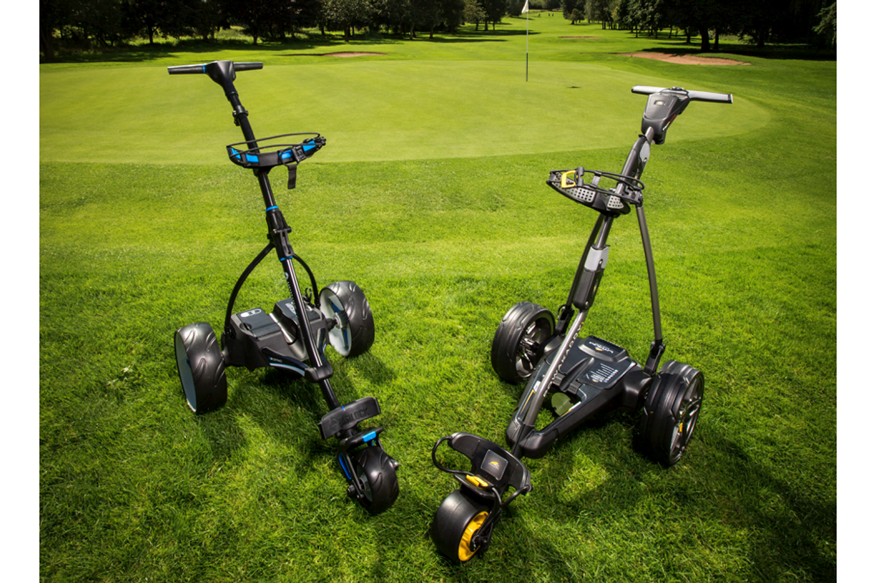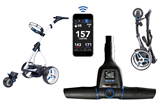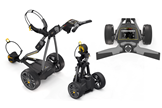REVIEW: GPS golf trolleys
Last updated:
GPS Trolleys Reviewed: We put the two best GPS trolleys on the market to the test.
The latest models from Motocaddy and PowaKaddy bring GPS yardages to your trolley in very different ways. But which does it best? We found out.
Some 69 per cent of golfers now use an electric trolley, while 75 per cent own a GPS measuring device. Combining the two, then, seems logical.
This summer has seen the two biggest electric trolley brands, Motocaddy and PowaKaddy, do exactly that.
Incorporating a GPS unit into the handle of the new trolleys means you get the distances to the front, centre and back of every green, which both companies say are the numbers most golfers really need.
Both companies have gone about integrating GPS into their trolleys in very different ways, so we felt the time was right to put the pair in a head-to-head test to see which does it best.
How we did it:
We asked both manufacturers to send us their new GPS models, Motocaddy’s S5 Connect and PowaKaddy’s FW7s GPS. Each battery was charged, each trolley had to be assembled and lifted in and out of a car boot and each was trialled over a number of rounds, in a variety of different conditions. We also had a laser on hand to check the distances given by the models were accurate.
Review: PowaKaddy FW7s GPS trolley £749.99
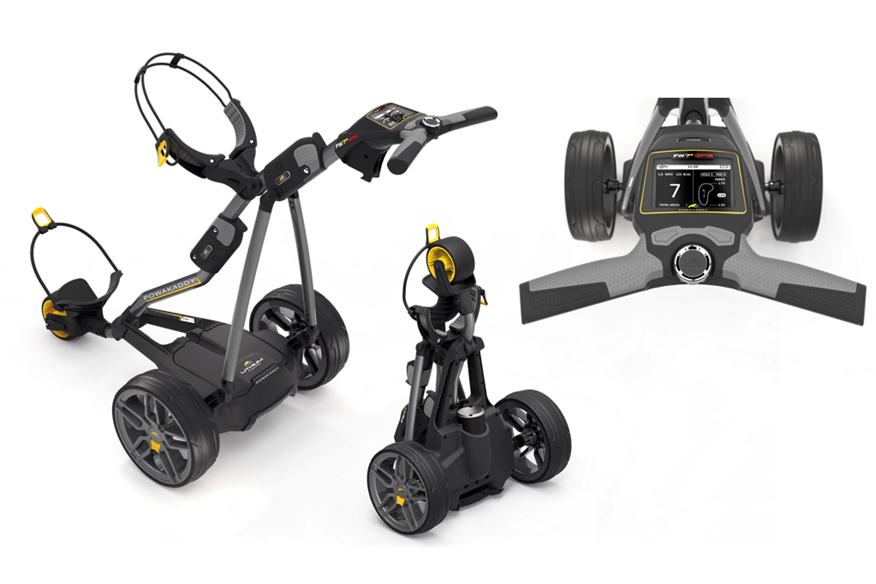
Weight: Trolley: 9.4kg Battery (18 hole lithium): 1.8kg Motor size: 230 watt
Warranty: Trolley: Three years. Lithium battery: Five years Folded size: 385mm x 860mm x 570mm
Review:
PowaKaddy have upped their game when it comes to the styling and design of their trolleys over the last few years. The FW7s GPS looks really good gliding down the fairway. And the simplicity of having a GPS built into the handle (rather than a phone) means setting it up couldn’t be easier. Simply select “play golf” and the system finds the course and off you go… it is that easy. The screen is a bit bigger than the Motocaddy, but it doesn’t mean you get more info. While the Motocaddy will (if you want) push notifications or call alerts to the handle, the FW7 lets you keep score, count the miles you’ve walked and keep track of how many calories you’ve burnt.
We loved…
It’s so simple to set up, and finds the course you’re at within seconds.
It’s a scorecard, too.
It’s has a lovely sleek upmarket, premium chassis design.
It counts your miles walked and calories burnt.
You don’t need your phone on the course.
We didn’t love…
Having the GPS tracker in the handle, rather than your phone, ramps up the price.
Can’t take it to a back tee/no other way of getting a course map to see what hazards are out there.
Bottom line:
We’d say the PowaKaddy FW7s GPS is a little more stylish than the Motocaddy, but only you can decide whether this is worth the £200 price difference. The FW7s is Powakaddy’s premium trolley so by combining it with GPS tech means it’s possible to buy an electric trolley and GPS system separately for less. If price isn’t a consideration, this a great looking, top spec machine which works brilliantly.
Review: Motocaddy S5 Connect trolley £549.99
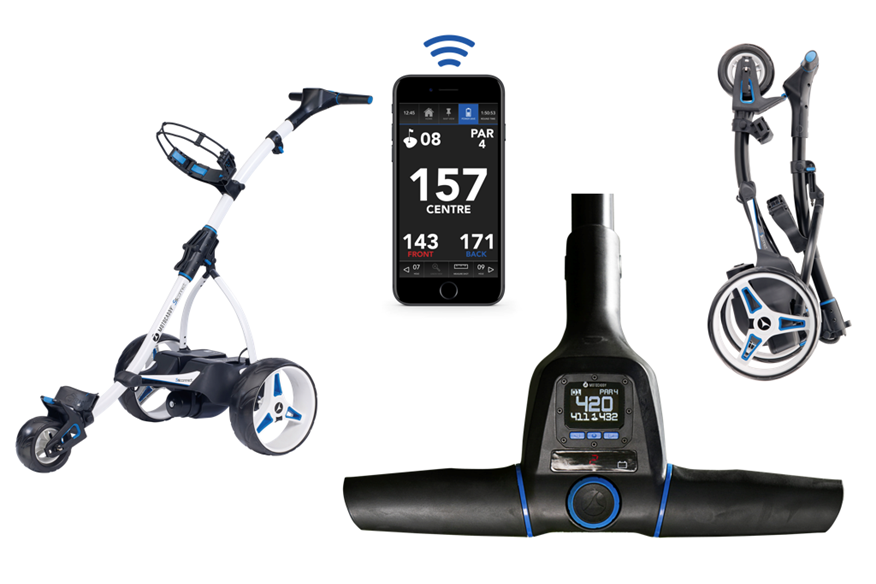
Models: S5 Connect £549.99 (standard lithium battery); £599.99 (extended lithium). Downhill Control (DHC) model £599.99 (standard), £649.99 (extended).
Weight: Trolley: 9kg Battery (18-hole lithium): 2.1kg Motor size: 200w
Warranty: Trolley and charger 24 months Battery: Five years Folded size: 850mm x 595mm x 355mm. Compatible with iPhone 4s or newer and Samsung Galaxy S4 or newer.
Review:
Motocaddy could have introduced a GPS golf trolley a few years ago, but the cost of a tracker (like the one used in smart phones) adds significantly to the cost of the trolley. So they waited until over 80% of the UK’s public owned a smart phone, allowing them to piggyback on the built in GPS tracker inside them all. It’s a clever bit of thinking and when it means the Motocaddy S5 Connect comes in £200 less than the PowaKaddy, it gives the S5 a competitive edge. We love how Motocaddy has invested in designing a fully bespoke (and free) GPS app, too. Making it available to all golfers for free is a real bonus for both brand and consumer. Initially we were sceptical of using a phone to power the system on the course (it uses Bluetooth to transfer data from phone to trolley, so your phone can be kept in your bag). But this makes a brilliantly simple job of integrating GPS tech into an electric trolley, and if you do want to see the shape of the hole, or any hazards, just grab your phone to view an aerial map on the app.
We love…
Free Motocaddy app so you have access to a full-blown GPS system.
It’s £200 less than the PowaKaddy.
You can take the GPS app (on your phone) to a back tee where you might not be able to take a trolley.
You can get or turn off notifications for texts, email, missed calls etc.
You can use the app during a round even if you don’t take your trolley.
It doesn’t work from your phone signal, so you don’t need network access on the golf course (download the course via wifi before playing to save data usage).
You can buy a cradle to fit your phone on to the trolley handle to access full GPS maps and charge your phone as you play via the built-in USB port.
We didn’t love…
The chassis isn’t quite as appealing as the PowaKaddy. An average round will use about 15 -20% of your phone’s battery. You’ll need the phone in your bag to power the system, which might not be ideal if you’re playing in torrential rain and don’t have a waterproof pocket. It takes a bit more initial setting up to pair your phone to the trolley, but you only do this once.
Bottom line:
Motocaddy has taken a really clever approach to integrating GPS into the world’s first “smart cart” – and we love it. Thanks to the price not being exorbitant it means a trolley and GPS purchase can be combined for far less than buying both independently. It’s a real pleasure to play with. You’ve got to admire the bespoke Motocaddy app; it’s free for anyone to download and works superbly.
